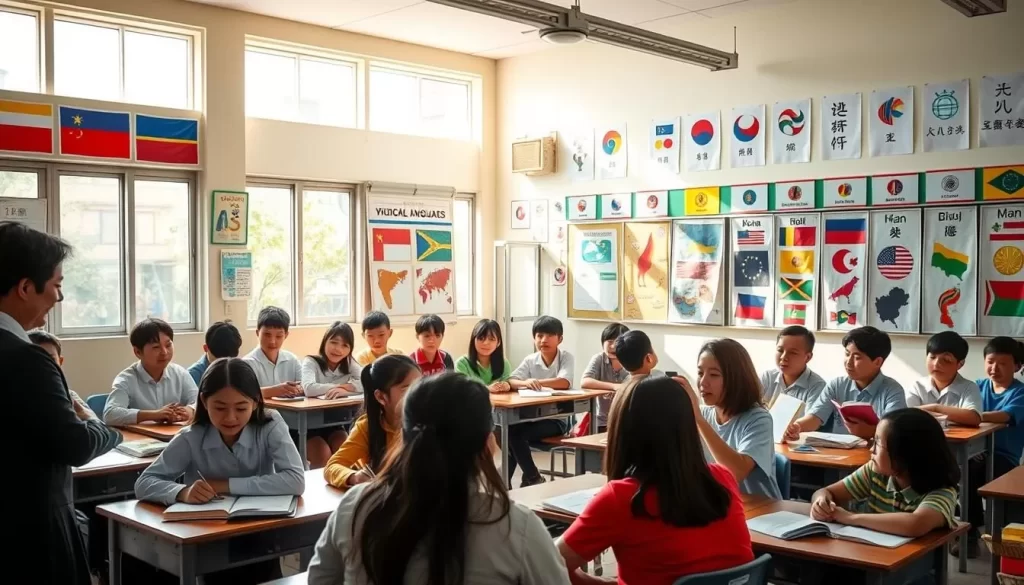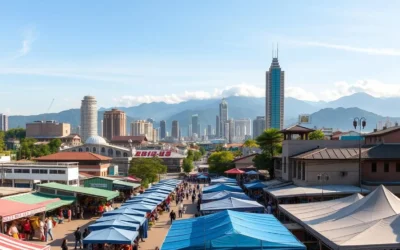✓ Accommodations✓ Flights✓ Rental Cars
As you explore Yilan County, you’ll uncover a rich tapestry of languages that reflect the region’s complex cultural heritage. With four official languages in Taiwan – Mandarin Chinese, Taiwanese Hokkien, Hakka, and Formosan languages – the linguistic landscape is diverse.
The prevalence of these languages varies, with Mandarin Chinese being almost universally spoken. You’ll find that Taiwanese Hokkien is also widely used, particularly in informal settings. Understanding the language dynamics in Yilan County will enhance your appreciation of the local culture and history.
The Linguistic Landscape of Yilan County
Yilan County, situated in northeastern Taiwan, boasts a rich tapestry of languages shaped by its unique geography and demographic makeup. As you explore this region, you’ll discover how its position has influenced the distribution of language throughout history.
Geographic and Demographic Overview of Yilan County
Yilan County is characterized by its diverse geography, ranging from coastal plains to mountainous areas. This varied landscape has contributed to the formation of distinct linguistic enclaves within the county. The population of Yilan County is approximately 460,000 people, with a mix of ethnic groups that contribute to its linguistic diversity.
- The county’s geography has played a significant role in shaping the linguistic identity of its inhabitants.
- The demographic composition includes various ethnic groups, each with their own language or dialects.
Language Diversity in Yilan County
The linguistic landscape of Yilan County is marked by a blend of languages, including Taiwanese Hokkien, Mandarin Taiwanese, and indigenous languages spoken by the indigenous people. This diversity is a result of historical migration patterns and the county’s cultural exchange with neighboring regions.
You’ll find that Yilan County’s language diversity is distinct from other counties in Taiwan, with a unique blend of Sinitic languages and Formosan languages. The population Taiwan has a significant impact on the linguistic landscape, with various speakers contributing to the rich linguistic heritage.
- The prevalence of Mandarin Taiwanese as an official language has influenced daily life and official communications.
- Taiwanese Hokkien remains a vital part of local culture and identity.
Mandarin Chinese: The Official Language
As the official language of Taiwan, Mandarin Chinese plays a crucial role in Yilan County’s linguistic landscape. You might be wondering how Mandarin became so deeply ingrained in the local culture. The history of Mandarin in Yilan County is closely tied to Taiwan’s broader linguistic evolution.
History of Mandarin in Yilan County
Mandarin Chinese was introduced to Taiwan in 1945, following the end of World War II. The Kuomintang (KMT) government made Mandarin the de facto official language, and it was made compulsory in schools. This marked the beginning of a new era in language education in Yilan County. Over the decades, Mandarin has become the primary language for official purposes, education, and inter-ethnic communication. As a result, Mandarin Chinese has become the lingua franca in Yilan County, bridging the gap between different linguistic communities.
The establishment of Mandarin as the official language was a gradual process that spanned several decades. From the late 1940s to the late 1970s, Mandarin was the only officially sanctioned medium of instruction in schools. This policy had a profound impact on the linguistic landscape of Yilan County, shaping the way people communicate in various domains of daily life.
Characteristics of Taiwanese Mandarin
While Mandarin Chinese is the official language, the version spoken in Taiwan, including Yilan County, has distinct characteristics. Taiwanese Mandarin has developed unique features in terms of pronunciation, vocabulary, and expressions. For instance, Taiwanese Mandarin has adopted words and phrases from other local languages, such as Hokkien and Hakka. This blending of linguistic elements has resulted in a distinct flavor of Mandarin that is different from the Mandarin spoken in mainland China.
Some of the distinctive features of Taiwanese Mandarin include:
- Pronunciation differences, such as variations in tone and intonation
- Vocabulary variations, including loanwords from other local languages
- Unique expressions and idioms that reflect local culture and customs

Usage and Prevalence in Daily Life
In Yilan County, Mandarin is widely used in various domains of daily life, including government offices, educational institutions, media, and public services. You can expect to hear Mandarin being spoken in most formal settings, as well as in informal conversations among people from different linguistic backgrounds.
The prevalence of Mandarin in daily life is particularly notable among the younger generations, who often use it as their primary language for communication. As a result, Mandarin has become an essential tool for social mobility and integration in Yilan County.
Taiwanese Hokkien: The Heart of Local Culture
As you explore Yilan County, you’ll discover that Taiwanese Hokkien is the cornerstone of its vibrant culture. Taiwanese Hokkien, commonly known as Taiwanese ( , Pe̍h-ōe-jī: Tâi-gí) and officially referred to as Taiwanese Hokkien (臺灣閩南語; Tâi-oân Bân-lâm-gú), is the most-spoken native language in Taiwan, spoken by about 70% of the population.
Origins and Evolution of Taiwanese Hokkien
Taiwanese Hokkien originated from southern Fujian Province in China. It arrived in Yilan County through migration and has since evolved over centuries, influenced by indigenous languages and historical events such as Japanese occupation. This evolution has enriched the language, making it a unique reflection of Yilan’s cultural heritage.
The language has adapted to the local context, incorporating elements from other languages spoken in the region. This blending of linguistic features has contributed to the distinctiveness of Taiwanese Hokkien in Yilan County.
The Lāi-po͘ Accent: Yilan’s Distinctive Dialect
One of the notable aspects of Taiwanese Hokkien in Yilan County is the Lāi-po͘ accent ( ), which characterizes the local dialect. This accent is closer to the Zhangzhou dialect in China and differs from other regional accents such as the Thong-hêng accent ( ) from Kaohsiung and the Hái-kháu accent ( ) from Lukang.
The Lāi-po͘ accent is not just a variation in pronunciation; it also includes unique vocabulary and expressions that are specific to Yilan County. For instance, certain words and phrases used in Yilan may differ significantly from those used in other parts of Taiwan.
Current Usage and Cultural Significance
Taiwanese Hokkien remains a vital part of daily life in Yilan County, used in various contexts such as markets, traditional ceremonies, and family gatherings. It is also a crucial element in local traditions, including folk songs, proverbs, and storytelling.
The language serves as a marker of local identity and cultural authenticity. It connects the people of Yilan to their heritage and plays a significant role in preserving the county’s cultural legacy.
Key aspects of Taiwanese Hokkien in Yilan County include:
- A rich history influenced by migration and cultural exchange
- A distinctive Lāi-po͘ accent that sets it apart from other dialects
- Significant role in local traditions and daily life
- A marker of local identity and cultural heritage
Hakka Language in Yilan County
Yilan County is home to a diverse linguistic landscape, including the Hakka language, which has a rich history in the region. The Hakka language is mainly spoken by people of Hakka ancestry, and while the majority of Hakka Taiwanese reside in Taoyuan, Hsinchu, and Miaoli, there is a significant Hakka population in Yilan County.
Communities in Yilan
The Hakka communities in Yilan County have maintained their linguistic heritage through various cultural practices. These communities are concentrated in specific areas, contributing to the preservation of the Hakka language. You can explore the distinctive cultural characteristics of these communities and how they’ve maintained their linguistic identity.
Preservation Efforts and Current Status
The Hakka language in Taiwan is maintained by the Hakka Affairs Council, a governmental agency that also runs Hakka TV and Hakka Radio stations. The government recognizes and maintains five Hakka dialects in Taiwan. In Yilan County, local initiatives and community organizations support the preservation of the Hakka language and culture.
| Hakka Dialects | Speakers in Yilan County | Preservation Efforts |
|---|---|---|
| Si-yen (Sixian) | Significant population | Language classes, cultural events |
| Ho-po (Hopo) | Smaller community | Community programs, media support |
| Other dialects | Varying populations | Government initiatives, local support |
The relationship between Hakka, Taiwanese Hokkien, and Mandarin speakers in Yilan’s multilingual environment is complex. Understanding the demographic trends affecting Hakka language use, including population shifts and intergenerational transmission patterns, is crucial for preserving the language.

Indigenous Formosan Languages in Yilan
As you explore Yilan County, you’ll discover the unique linguistic diversity of its indigenous peoples, including the Atayal and Kavalan communities. The indigenous Formosan languages are a vital part of Taiwan’s cultural heritage, with Yilan being home to some of these languages. The Taiwanese indigenous peoples, comprising about 2.3% of the island’s population, have seen their languages face significant challenges over the centuries.
Atayal and Kavalan Languages
The Atayal and Kavalan languages are two of the indigenous Formosan languages found in Yilan County. These languages are distinct from the Sinitic languages spoken in the region, such as Mandarin Chinese and Taiwanese Hokkien. The Atayal language is known for its complex grammar and phonology, which includes a range of consonant and vowel sounds not found in many other languages. The Kavalan language, on the other hand, is known for its rich oral traditions and cultural significance to the Kavalan people.
Historically, the Atayal and Kavalan languages have been spoken in various parts of Yilan County. However, due to factors such as urbanization and language shift towards more dominant languages like Mandarin Chinese, the number of fluent speakers has declined. Efforts to document and preserve these languages are underway, including language documentation projects and community-based language education programs.
| Language | Speaker Population | Status |
|---|---|---|
| Atayal | Approximately 80,000 | Vulnerable |
| Kavalan | Less than 1,000 | Endangered |
Revitalization Initiatives and Challenges
Revitalizing indigenous languages in Yilan County involves a multi-faceted approach, including educational programs, community language nests, and documentation projects. These initiatives aim to not only teach the languages but also to promote their use in daily life and cultural practices. Community involvement is crucial, with many programs relying on the participation of elder speakers and community members.
Despite these efforts, challenges persist, including limited resources, demographic shifts, and the influence of dominant languages. The role of technology, such as language learning apps and online resources, is becoming increasingly important in reaching younger generations and supporting language preservation.
By supporting indigenous language revitalization efforts, you contribute to preserving the cultural heritage and diversity of Yilan County. As you learn more about the Atayal and Kavalan languages, you gain a deeper understanding of the region’s history and the importance of linguistic diversity.
Yilan County, Taiwan: Official and Widely Spoken Languages in Education
As you explore the educational landscape of Yilan County, you’ll discover the complex interplay between official and widely spoken languages. The region’s language education policies have evolved significantly over the years, reflecting broader cultural and political shifts in Taiwan.
Language Education Policies
After the lifting of Martial Law in Taiwan in 1987, there was a gradual shift towards promoting local languages and cultures in the education system. This movement gained momentum in 2000 with the election of Chen Shui-bian’s DPP party, which actively promoted the localization of Taiwanese culture, including its indigenous languages. As a result, Taiwanese language classes were introduced into elementary school curricula, marking a significant step towards linguistic diversity.
The current language education policies in Yilan County reflect a balance between promoting Mandarin Chinese as the national language and preserving local languages such as Taiwanese Hokkien, Hakka, and indigenous Formosan languages. The Ministry of Education plays a crucial role in shaping these policies, ensuring that they align with national objectives while catering to local needs.
| Language | Level of Education | Curriculum Inclusion |
|---|---|---|
| Mandarin Chinese | Primary to Higher Education | Core subject |
| Taiwanese Hokkien | Primary Education | Elective subject |
| Hakka | Primary Education | Elective subject |
| Indigenous Formosan Languages | Primary Education | Elective subject |
Multilingual Education Programs
Yilan County has been at the forefront of implementing innovative multilingual education programs. These programs aim to preserve linguistic diversity while ensuring proficiency in Mandarin Chinese. Schools in Yilan have adopted various approaches, including bilingual and trilingual education models, to cater to the linguistic needs of their students.
One successful case study is the implementation of a trilingual program in a local elementary school, where students are taught in Mandarin Chinese, Taiwanese Hokkien, and English. This approach not only helps in preserving local languages but also enhances the students’ proficiency in a global language.

By embracing multilingual education, Yilan County is setting an example for linguistic preservation and cultural identity in Taiwan. As you delve deeper into the specifics of language education in Yilan, it becomes clear that the region is making significant strides in balancing the promotion of Mandarin with the preservation of local languages.
Writing Systems and Literacy
You’ll find a multifaceted writing landscape in Yilan County, with various systems in use to represent different languages. The county’s linguistic diversity necessitates a range of writing systems, each serving a unique purpose.
Traditional Chinese Characters
Traditional Chinese characters are the backbone of writing in Yilan County, used for Sinitic languages such as Mandarin, Taiwanese Hokkien, and Hakka. The Ministry of Education in Taiwan maintains standards for these languages, publishing guidelines like the Standard Form of National Characters and recommended characters for Taiwanese Hokkien and Hakka. This ensures consistency in writing across different languages and dialects.
Usage of Traditional Chinese Characters is widespread, with regional character variants and preferences being considered. For instance, characters for Taiwanese Hokkien include both shared characters with Mandarin and unique characters specific to Hokkien.
Romanization Systems
Romanization systems play a crucial role in Yilan County, particularly for languages like Taiwanese Hokkien and Hakka, and Formosan languages. Systems such as Pe̍h-ōe-jī and Pha̍k-fa-sṳ, developed under the influence of European missionaries, utilize the Latin alphabet. These systems are vital for language education, street signs, and other purposes.
The use of romanization systems facilitates the representation of local languages in a format accessible to a broader audience, including tourists and language learners.
Zhuyin Phonetic Symbols
Zhuyin Fuhao, or Bopomofo, is Taiwan’s phonetic system for teaching the pronunciation of Chinese characters, especially in Mandarin. It is an essential tool in Yilan County’s education system, helping learners master the correct pronunciation of characters.
The application of Zhuyin Phonetic Symbols extends beyond education, serving as a pronunciation guide in daily life. This system is particularly useful for learning Mandarin and other Sinitic languages.
In conclusion, Yilan County’s writing systems and literacy practices are characterized by a blend of traditional and phonetic systems. Understanding these systems provides insight into the county’s linguistic and cultural landscape.
Language Shift and Preservation Efforts
As you explore Yilan County, you’ll discover the intricate balance between language loss and preservation. The county’s linguistic landscape is characterized by a complex interplay of historical, cultural, and political factors that have influenced language use over time.

Historical Context of Language Suppression
During the Japanese colonial period (1895-1945), the use of Taiwanese languages was discouraged, and Japanese became the official language for government and education. Later, in 1949, when the KMT took control of Taiwan, Mandarin Chinese was established as the official language, continuing the suppression of local languages like Taiwanese Hokkien and indigenous Formosan languages. Using these languages in public was often punished, leading to a significant shift towards Mandarin.
Key historical events that contributed to language suppression include:
- The imposition of Japanese during the colonial period
- The KMT’s promotion of Mandarin Chinese post-1949
- Punishments for using local languages in public
Modern Revitalization Initiatives
In recent decades, there has been a growing awareness of the importance of preserving local languages and cultures. Various initiatives have been launched to revitalize Taiwanese Hokkien, Hakka, and indigenous Formosan languages. These include language education programs in schools, cultural events, and community activities aimed at promoting the use of these languages among younger generations.
Some notable initiatives include:
- Reintroduction of Formosan mother tongue education in schools
- Community-based language classes for adults and children
- Cultural festivals celebrating local languages and traditions
Government Support and Policies
The government has started to recognize the importance of linguistic diversity, implementing policies to support language preservation. In July 2017, Formosan languages were officially recognized as part of Taiwan’s linguistic heritage. Efforts to document and promote these languages are ongoing, with support from both national and local government levels.
Key government initiatives include:
- Official recognition of Formosan languages
- Funding for language documentation and education programs
- Promotion of multilingualism in public services
Code-Switching and Multilingualism in Yilan
As you explore the linguistic diversity of Yilan, you’ll discover that code-switching plays a significant role in everyday communication. In Yilan County, the ability to switch between languages is not just a skill, but a common practice that reflects the multilingual nature of the society.
Patterns of Language Mixing
Bilingual Taiwanese speakers often code-switch between Mandarin Chinese and Taiwanese Hokkien, sometimes within the same sentence. This linguistic flexibility is influenced by factors such as context, topic, and the person they are communicating with. For instance, a person might speak Mandarin at a formal setting like a bank, then switch to Taiwanese Hokkien when interacting with a local street food vendor.
The patterns of language mixing in Yilan are complex and governed by social rules. For example, the choice of language can depend on the formality of the situation or the cultural identity the speaker wishes to convey. This code-switching is not random; it is a sophisticated linguistic strategy that reflects the speaker’s ability to navigate different social contexts.
| Context | Common Language Used | Reason for Choice |
|---|---|---|
| Formal Settings (e.g., Bank) | Mandarin Chinese | Official and professional communication |
| Informal Settings (e.g., Street Food Vendors) | Taiwanese Hokkien | Cultural familiarity and local identity |
Generational Differences in Language Use
There’s a notable difference in language proficiency and usage patterns among different generations in Yilan. Younger generations tend to use Mandarin more frequently in daily life, especially in formal education and professional environments. In contrast, older generations often prefer Taiwanese Hokkien for informal communication.
This generational shift affects how languages are used and perceived. While younger people are proficient in Mandarin due to its prominence in education and media, they may also use Taiwanese Hokkien to connect with their cultural heritage. Understanding these dynamics is crucial for appreciating the multilingual identity of Yilan County.
English and Other Foreign Languages in Yilan County
In Yilan County, the importance of English and other foreign languages is growing, driven by globalization and international connections. As a result, the county is witnessing a significant shift in its linguistic landscape.
English Education and Usage
English learning is a multi-billion dollar industry in Taiwan, and Yilan County is no exception. Virtually all students in Yilan County learn English in schools, cram schools, and from private tutors. English is vital for business professionals, government workers, and those in the tourism industry, where it serves as a lingua franca for international communication.
The practical uses of English in Yilan County are evident in its tourism industry, international business connections, and higher education. For instance, many universities in Taiwan, including those with campuses or programs in Yilan County, offer programs taught in English, attracting both local and international students.
| Demographic Group | English Proficiency Level | Primary Use of English |
|---|---|---|
| Students | Basic to Intermediate | Education |
| Business Professionals | Intermediate to Advanced | International Business |
| Tourism Industry Workers | Basic to Advanced | Customer Service |
Japanese, Korean, and Other Languages
Due to Taiwan’s historical period under Japanese rule, Japanese has left a lasting impact on the languages spoken in Yilan County. Many loanwords from Japanese are used in Formosan languages, and there’s even a unique phenomenon known as Yilan Creole Japanese, a mixture of Japanese and Atayal. This creole language is a fascinating example of linguistic evolution and cultural exchange.
In addition to English and Japanese, other foreign languages such as Korean, Southeast Asian languages, and European languages are becoming more prevalent in Yilan County. This growing linguistic diversity is a result of globalization and international migration, creating new dynamics in the county’s language landscape.
Conclusion: The Future of Languages in Yilan County
The diverse linguistic landscape of Yilan County is a complex and dynamic entity. As you’ve seen, language plays a vital role in shaping the identity and cultural heritage of this unique region.
The future of languages in Yilan County, including Formosan languages and Taiwanese Hokkien, depends on various factors, including government policies, community involvement, and technological advancements.
A key to preserving these languages is developing a standardized writing system and inputting system for Taiwanese, similar to pinyin and zhuyin used for Mandarin.
By understanding the challenges and opportunities facing language preservation in Yilan, you’ll appreciate the importance of community efforts in maintaining linguistic diversity. As you consider the future of language in Yilan County, it’s clear that a collaborative approach is necessary to ensure the continued vitality of its linguistic heritage.
The above is subject to change.
Check back often to TRAVEL.COM for the latest travel tips and deals.






